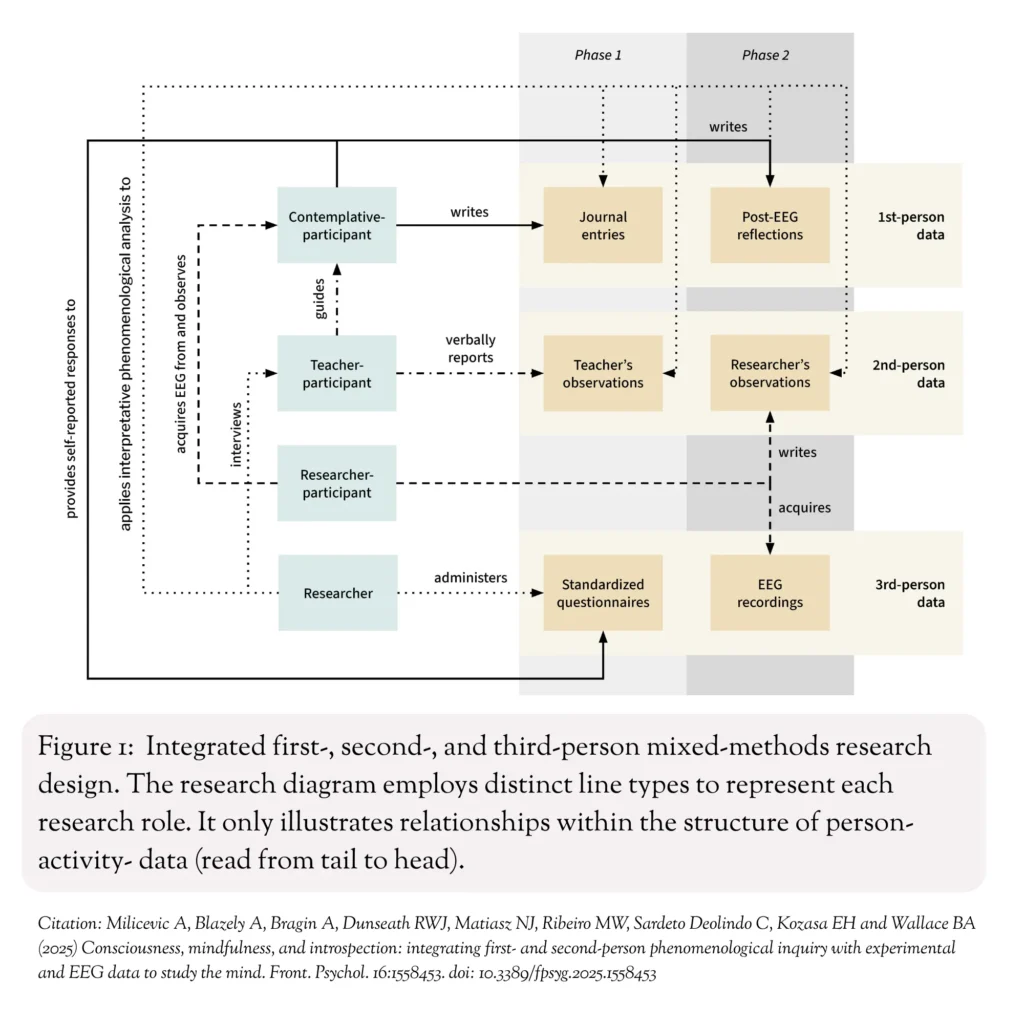
The CCR's “Pilot Study” yields its first peer-reviewed research article, available to read for free in Frontiers in Psychology
Since 2020, the CCR’s Research Team has been conducting a mixed-methods study on the phenomenology of shamatha- and vipashyana-based meditation retreats for full-time contemplatives-in-training. Concisely referred to as the CCR’s “Pilot Study” and led by Principal Investigator Dr. Anita Milicevic, this flagship project combines the expertise of researchers across three continents. Now, after five years of planning, data collection, and analysis, the CCR is delighted to announce the first of multiple research articles expected from this project: a methodology paper titled “Consciousness, mindfulness, and introspection: integrating first- and second-person phenomenological inquiry with experimental and EEG data to study the mind,” now available in the journal Frontiers in Psychology.
As the authors discuss in the paper, the Pilot Study operationalizes a core strategy of our contemplative-scientific research program: combining first-, second-, and third-person data to maximally triangulate perspectives on the mind. The study seeks convergence across these methods so that each can illuminate what the others cannot—and, where needed, compensate for potential biases in the other methods. (Those seeking to learn more about the epistemological justification for this approach may be interested in a recent book chapter on the subject by B. Alan Wallace and Nicholas J. Matiasz; a full preview is available here.)
For instance, contemplatives-in-training who are enrolled in the study write journal entries about their meditation practices. This first-person data conveys nuances about subjective experience in a way that third-person measures like psychological questionnaires and EEG simply do not. But as many people who have meditated can attest, it can be easy to be mistaken about one’s own progress. While the meditation teachers guiding the contemplatives-in-training do not read the first-person research journal entries, they offer second-person data, by reporting their perspectives on participant progress.
Lastly, EEG provides evidence about brain activity that may be correlated with mental processes occurring during meditation—a form of third-person physical evidence that does not share the same susceptibilities to bias seen in first- and second-person reporting. The power of this mixed-methods approach lies not in merely collecting multiple forms of evidence but in integrating them. Of course, these disparate data streams cannot be combined as simply as adding three numbers (e.g., 3 + 2 + 1 = 6); more elaborate integration procedures are needed. Part of the CCR’s research program—and part of the aim of this new paper—is to articulate procedures for integrating diverse forms of first-, second-, and third-person evidence on the nature and potentials of consciousness. Through such integration procedures, synthesized knowledge can be derived from these data streams—knowledge that cannot typically be obtained from simply analyzing the data streams in isolation.
The authors argue that this mixed-methods research has been underused in studies involving meditators. For the growing field known as contemplative science, the lesson is practical: careful first- and second-person data—although rooted in subjectivity—can strengthen the scientific method by yielding phenomenological descriptions that help interpret psychological and neuropsychological findings. The goal is not to achieve objectivity by rejecting the subjective, but to recognize that objectivity is achieved only via intersubjective agreement, through honing the mind so that expert consensus can be reached and then further corroborated by third-person means.
In response to this need, the study applied Interpretative Phenomenological Analysis (IPA), to bridge contemplative science and Western psychology, and to integrate first-, second-, and third-person data, creating new forms of knowledge. This paper thus gives the CCR’s research program a clear, citable template for seeking this form of convergence, while highlighting a gap in the theoretical and methodological thinking behind this type of research. That is, most meditation studies still don’t treat contemplatives as true researchers of the mind. The CCR’s Mind Lab and Research domains are designed precisely to address this gap.